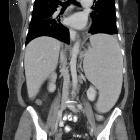polycythaemia rubra vera



Polycythemia vera (older term: polycythemia rubra vera) is a myeloproliferative neoplasm that results in an excess of red blood cells in the bloodstream.
Epidemiology
The estimated prevalence is around 2-3 per 10,000 people. It typically presents in older individuals. There may be a slightly greater male predilection.
Pathology
Markers
JAK2 mutations (particularly the V617F mutation) can be found in more than 95% of people with polycythemia vera.
Diagnostic criteria
Major WHO criteria are as follows:
Hemoglobin >16.5 g/dL in men and >16 g/dL in women, or hematocrit >49% in men and >48% in women, or red cell mass >25% above mean normal predicted value
Bone marrow biopsy showing hypercellularity for age with trilineage growth (panmyelosis) including prominent erythroid, granulocytic, and megakaryocytic proliferation with pleomorphic, mature megakaryocytes (differences in size)
Presence of JAK2V617F or JAK2 exon 12 mutation
The minor WHO criterion is as follows:
Serum erythropoietin level below the reference range for normal
Radiographic features
Radiographic manifestations are varied and non-specific and can affect a number of systems, including:
- splenomegaly
- organ infarcts e.g. splenic infarcts
- features of extramedullary hematopoiesis
- increased radiographic attenuation of cerebral arteries, veins and dural sinuses (may mimic cerebral vein thrombosis)
Complications
- splenic infarction
- venous thromboses
- cerebrovascular events
- myocardial infarction
Treatment and prognosis
The overall prognosis can be variable with a wide natural course amongst individuals. Treatment options include venesection, myelosuppressive medications, interferon, and aspirin.
Anagrelide is used when secondary thrombocythemia is an issue. Oral radiophosphorus (32-P) is now avoided in 'benign' myeloproliferative diseases due to the risk of inducing acute myeloid leukemia .
See also
Siehe auch:
und weiter:

 Assoziationen und Differentialdiagnosen zu Polycythaemia vera:
Assoziationen und Differentialdiagnosen zu Polycythaemia vera:
